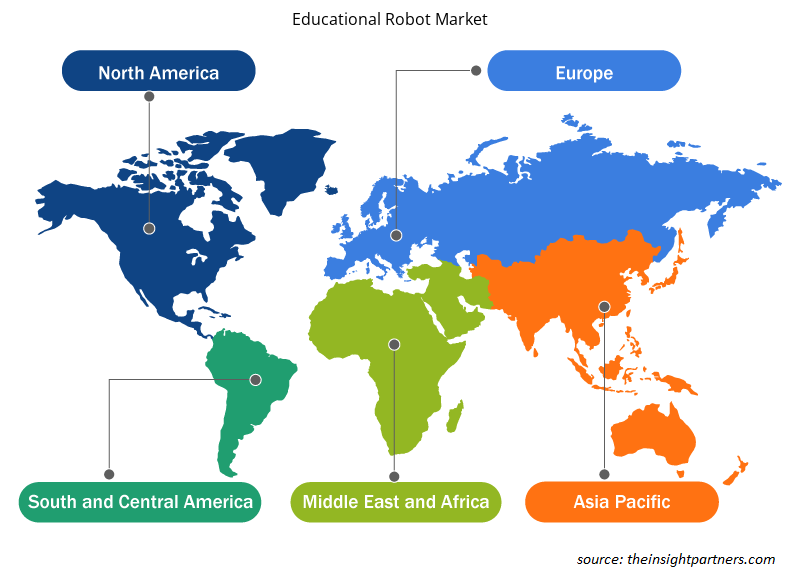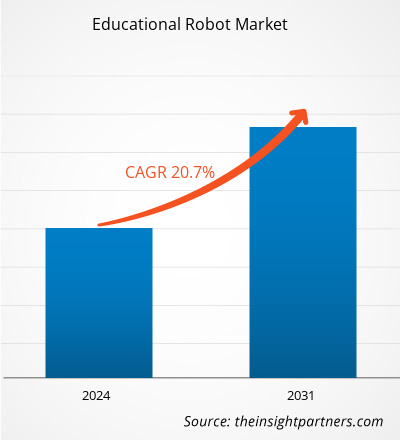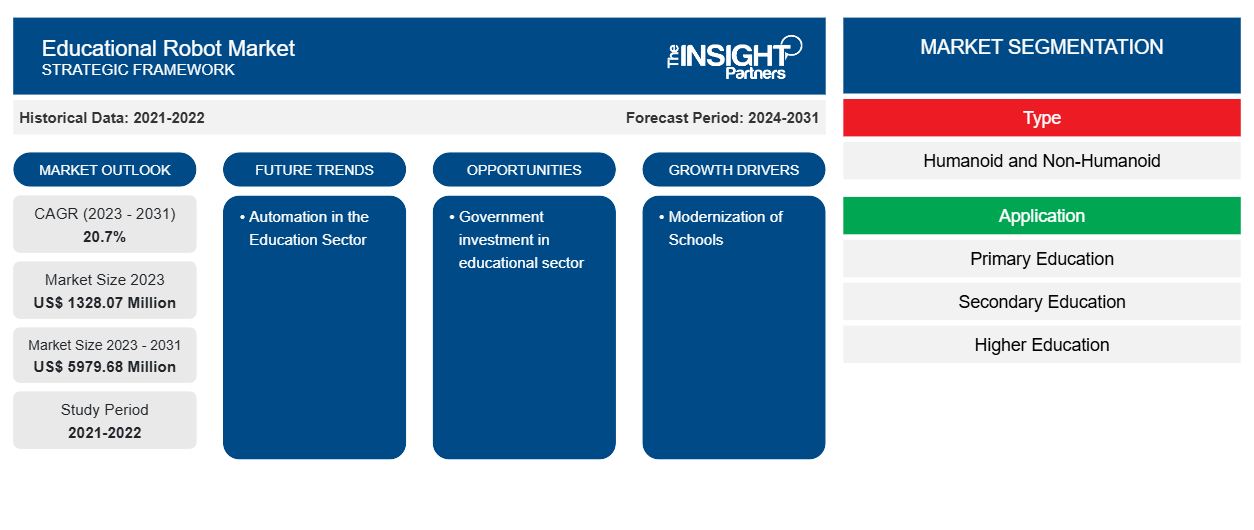Se proyecta que el mercado de robots educativos alcance los 5979,68 millones de dólares en 2031, frente a los 1328,07 millones de dólares en 2023. Se espera que el mercado registre una CAGR del 20,7 % durante el período 2023-2031. Es probable que la inversión gubernamental en robótica y automatización en el sector educativo siga siendo una tendencia clave en el mercado.CAGR of 20.7% during 2023–2031. The government investment in robotics and automation in the education sector are likely to remain key trends in the market.
Análisis del mercado de robots educativos
El creciente interés por mejorar la ciencia, la tecnología, la ingeniería y las matemáticas (STEM) está impulsando el crecimiento del mercado. Las inversiones en el sistema educativo por parte de las autoridades gubernamentales fomentan aún más el crecimiento del mercado. Las escuelas y universidades están incluyendo diversos aspectos de la robótica que impulsan el crecimiento del mercado.
Descripción general del mercado de robots educativos
Los robots educativos son robots programables que permiten a los estudiantes de todas las edades profundizar sus conocimientos de robótica y programación. Además, les ayuda a aprender otras habilidades cognitivas. Proporciona a los estudiantes todo lo que necesitan para construir y programar un robot que pueda realizar una variedad de tareas.
Personalice este informe según sus necesidades
Obtendrá personalización en cualquier informe, sin cargo, incluidas partes de este informe o análisis a nivel de país, paquete de datos de Excel, así como también grandes ofertas y descuentos para empresas emergentes y universidades.
-
Obtenga las principales tendencias clave del mercado de este informe.Esta muestra GRATUITA incluirá análisis de datos, desde tendencias del mercado hasta estimaciones y pronósticos.
Factores impulsores y oportunidades del mercado de robots educativos
Modernización de las escuelas
El gobierno está invirtiendo fuertemente en el sector educativo para modernizar las escuelas y colegios y mejorar aún más el aprendizaje de los estudiantes. Estas inversiones están animando a los actores del mercado a proporcionar sus robots educativos en las escuelas, lo que está impulsando el crecimiento del mercado. Por ejemplo, en abril de 2022, Shape Robotics de Dinamarca dijo que había firmado un acuerdo con su homólogo local KUBO Robots para distribuir robots educativos a las escuelas de Rumania.
Automatización en el sector educativo
La encuesta global de ABB de 2023 a 2.301 profesionales de la educación descubrió que el 80 por ciento cree que los robots y la automatización darán forma al futuro del empleo en los próximos diez años. El uso de robots en el sistema educativo y los programas de enseñanza. Los actores del mercado de robots industriales se centran en el lanzamiento de robots en el sector educativo que puedan impulsar el mercado de robots educativos en el futuro.
Análisis de segmentación del informe de mercado de robots educativos
Los segmentos clave que contribuyeron a la derivación del análisis del mercado de robots educativos son el tipo y la aplicación.
- Según el tipo, el mercado de robots educativos se segmenta en humanoides y no humanoides. El segmento de los no humanoides tuvo la mayor participación del mercado en 2023.
- Por aplicación, el mercado se segmenta en educación primaria, educación secundaria, educación superior y otros. El otro segmento tenía una participación significativa del mercado en 2023.
Análisis de la cuota de mercado de robots educativos por geografía
El alcance geográfico del informe del mercado de robots educativos se divide principalmente en cinco regiones: América del Norte, Asia Pacífico, Europa, Medio Oriente y África, y América del Sur y Central.
Se espera que la región de Asia Pacífico crezca con la CAGR más alta durante el período de pronóstico. La región se centra en el avance tecnológico en el sector educativo. La creciente inversión en el sector educativo complementa el crecimiento del mercado. La introducción de robots en las escuelas impulsa aún más el crecimiento del mercado en la región. Por ejemplo, en marzo de 2024, una escuela de Kerala presentó a la primera maestra de inteligencia artificial del país, Iris, para dar un paso innovador hacia la educación. Iris se creó en asociación con Makerlabs Edutech y es el primer robot docente humanoide del estado y probablemente del país. Iris es capaz de responder consultas complejas sobre diversas materias, ofrecer asistencia de voz individualizada y promover oportunidades educativas interactivas. Además, Iris está equipada con ruedas para aumentar la movilidad.CAGR during the forecast period. The region is focused on technological advancement in the educational sector. The rising investment in the educational sector Kerala school introduced the country’s first AI Teacher, Iris to take an innovative step towards education. Iris was created in partnership with Makerlabs Edutech and is the state's and probably the nation's first humanoid robot teacher. Iris is capable of answering intricate queries across various subjects, offering individualized voice support, and promoting interactive educational opportunities. In addition, Iris is equipped with wheels to increase mobility.
Perspectivas regionales del mercado de robots educativos
Los analistas de Insight Partners explicaron en detalle las tendencias y los factores regionales que influyen en el mercado de robots educativos durante el período de pronóstico. Esta sección también analiza los segmentos y la geografía del mercado de robots educativos en América del Norte, Europa, Asia Pacífico, Oriente Medio y África, y América del Sur y Central.

- Obtenga datos regionales específicos para el mercado de robots educativos
Alcance del informe sobre el mercado de robots educativos
| Atributo del informe | Detalles |
|---|---|
| Tamaño del mercado en 2023 | US$ 1328,07 millones |
| Tamaño del mercado en 2031 | US$ 5979,68 millones |
| CAGR global (2023 - 2031) | 20,7% |
| Datos históricos | 2021-2022 |
| Período de pronóstico | 2024-2031 |
| Segmentos cubiertos |
Por tipo
|
| Regiones y países cubiertos |
América del norte
|
| Líderes del mercado y perfiles de empresas clave |
|
Densidad de actores del mercado de robots educativos: comprensión de su impacto en la dinámica empresarial
El mercado de robots educativos está creciendo rápidamente, impulsado por la creciente demanda de los usuarios finales debido a factores como la evolución de las preferencias de los consumidores, los avances tecnológicos y una mayor conciencia de los beneficios del producto. A medida que aumenta la demanda, las empresas amplían sus ofertas, innovan para satisfacer las necesidades de los consumidores y aprovechan las tendencias emergentes, lo que impulsa aún más el crecimiento del mercado.
La densidad de actores del mercado se refiere a la distribución de las empresas o firmas que operan dentro de un mercado o industria en particular. Indica cuántos competidores (actores del mercado) están presentes en un espacio de mercado determinado en relación con su tamaño o valor total de mercado.
Las principales empresas que operan en el mercado de robots educativos son:
- Robótica Aisoy
- Hanson Robotics Limited
- Robótica modular
- Robótica PAL
- Corporación FANUC América
- Tecnología de innovación Sanbot Ltd.
Descargo de responsabilidad : Las empresas enumeradas anteriormente no están clasificadas en ningún orden particular.

- Obtenga una descripción general de los principales actores clave del mercado de robots educativos
Noticias y desarrollos recientes del mercado de robots educativos
El mercado de robots educativos se evalúa mediante la recopilación de datos cualitativos y cuantitativos a partir de investigaciones primarias y secundarias, que incluyen publicaciones corporativas importantes, datos de asociaciones y bases de datos. A continuación, se enumeran algunos de los avances en el mercado de robots educativos:
- ABB Robotics ha ampliado su oferta educativa con el lanzamiento del IRB 1090. El robot educativo industrial 1090, autentificado por el instituto educativo STEM.org, reconocido mundialmente, está diseñado para mejorar las habilidades de los estudiantes y brindarles una ventaja competitiva para conseguir empleo. El nuevo robot educativo forma parte fundamental de la oferta educativa más amplia de ABB, que incluye robots industriales adicionales, así como paquetes educativos, controladores de última generación y software de simulación y programación líder en el mercado. (Fuente: ABB Robotics, nota de prensa, septiembre de 2023)
- MatataStudio, un proveedor de soluciones de aprendizaje digital con innovación y originalidad como ejes centrales, lanzó un nuevo kit de robot educativo llamado "VinciBot", con el objetivo de combinar informática, inteligencia artificial y educación de forma entretenida. Conceptos de alta tecnología como (IA) y aprendizaje automático (ML) se introducen en las aulas de la escuela primaria. Estos kits de robótica no solo son altamente educativos, sino que también incorporan programación, pensamiento computacional, creatividad y exploración. El concepto de diseño de MatataStudio es alentar a los niños a dominar los conocimientos básicos de programación y informática mediante la construcción y operación de robots con sus propias manos mientras cultivan su pensamiento innovador y sus habilidades para resolver problemas. (Fuente: MatataStudio, comunicado de prensa, febrero de 2024)
Cobertura y resultados del informe sobre el mercado de robots educativos
El informe "Tamaño y pronóstico del mercado de robots educativos (2021-2031)" proporciona un análisis detallado del mercado que cubre las siguientes áreas:
- Tamaño del mercado de robots educativos y pronóstico a nivel global, regional y nacional para todos los segmentos clave del mercado cubiertos bajo el alcance
- Tendencias del mercado de robots educativos, así como dinámicas del mercado, como impulsores, restricciones y oportunidades clave
- Análisis detallado de las cinco fuerzas de Porter y PEST y FODA
- Análisis del mercado de robots educativos que cubre las tendencias clave del mercado, el marco global y regional, los principales actores, las regulaciones y los desarrollos recientes del mercado
- Análisis del panorama de la industria y de la competencia que abarca la concentración del mercado, el análisis de mapas de calor, los actores destacados y los desarrollos recientes en el mercado de robots educativos
- Perfiles detallados de empresas
- Análisis histórico (2 años), año base, pronóstico (7 años) con CAGR
- Análisis PEST y FODA
- Tamaño del mercado, valor/volumen: global, regional y nacional
- Industria y panorama competitivo
- Conjunto de datos de Excel
Informes recientes
Informes relacionados
Testimonios
Razón para comprar
- Toma de decisiones informada
- Comprensión de la dinámica del mercado
- Análisis competitivo
- Información sobre clientes
- Pronósticos del mercado
- Mitigación de riesgos
- Planificación estratégica
- Justificación de la inversión
- Identificación de mercados emergentes
- Mejora de las estrategias de marketing
- Impulso de la eficiencia operativa
- Alineación con las tendencias regulatorias























 Obtenga una muestra gratuita para - Mercado de robots educativos
Obtenga una muestra gratuita para - Mercado de robots educativos